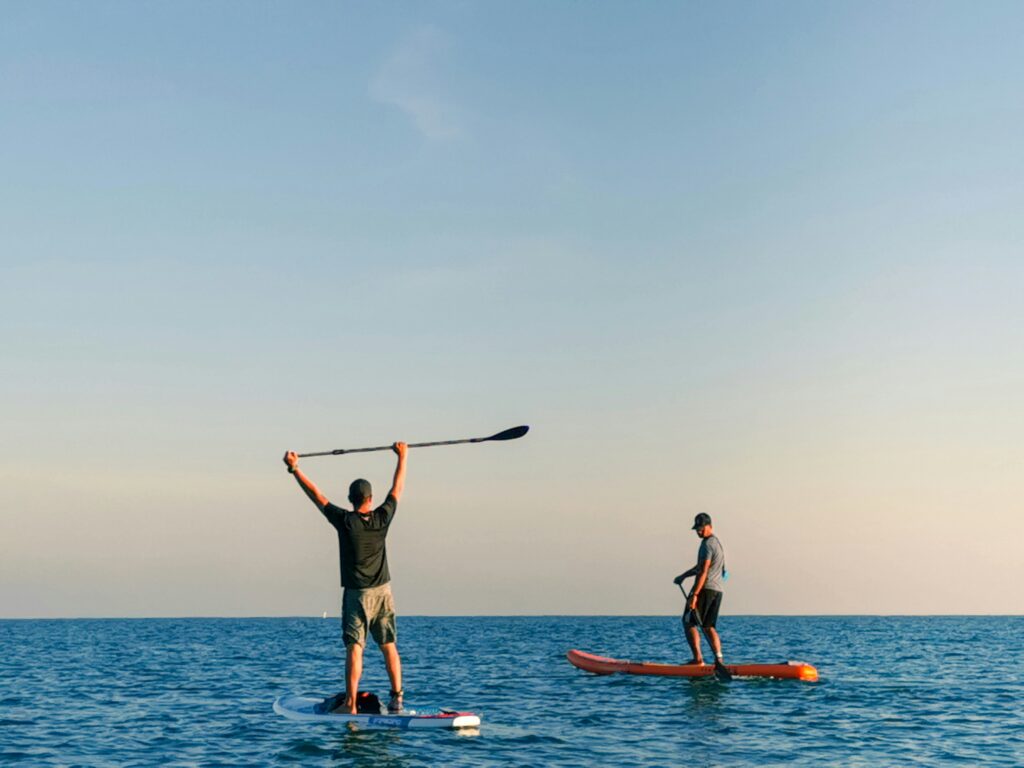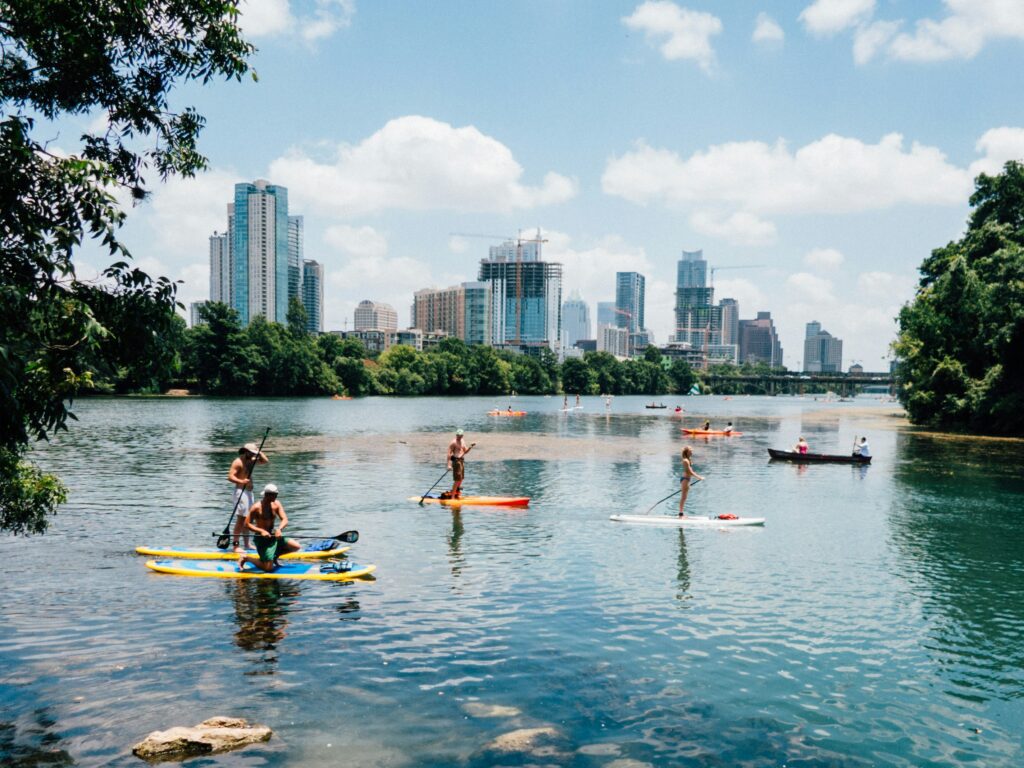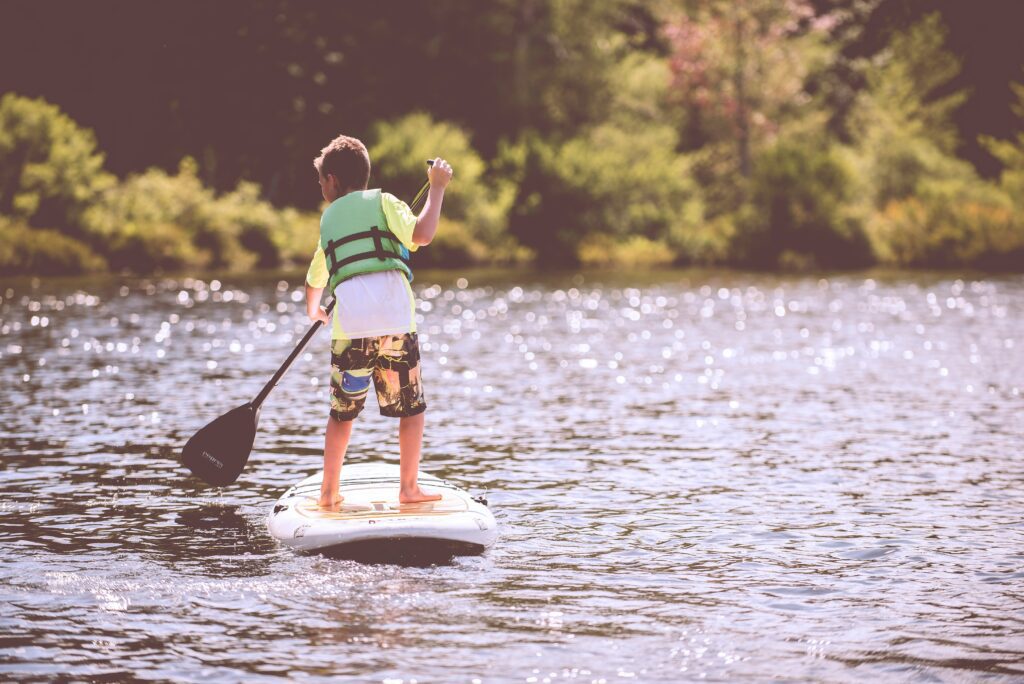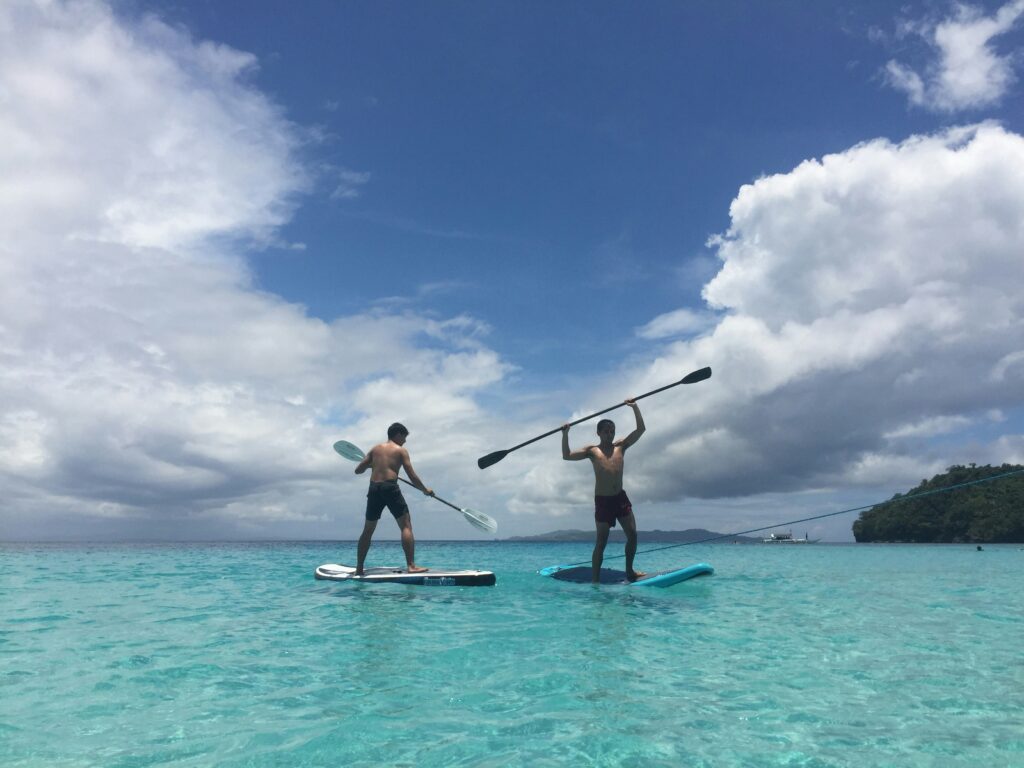Stand Up and Paddle: Mastering the Art of Paddle Board Rentals
Paddle boarding has taken the world by storm, and it’s easy to see why. It’s a fun and exciting way to experience the water while getting a full-body workout. But what if you don’t own a paddle board, or are new to the sport? No worries – paddle board rentals are here to save the day!
The Rising Wave of Paddle Board Popularity
Stand up paddle boarding (SUP) has gained immense popularity over the years, with more and more people looking to hit the water and improve their paddling skills. For some, purchasing a paddle board can be out of their budget and unrealistic. This is where paddle board rentals come in handy. They are an affordable alternative to buying expensive paddle boards and offer a fantastic way to dip your toes into the world of SUP.
Renting a paddle board is easy and convenient. Most specialized rental companies offer various paddle boards, kayaks, and accessories to choose from – catering to both beginners and experienced SUP enthusiasts. You can check online or ask around your local area to find rental spots near you.
Rental rates may vary, but prices tend to be reasonable. For instance, you could find options with rates as low as $99 for two days. This generally includes the paddle board, paddle, leash, and personal flotation device. Some rental companies even offer free shipping anywhere in the US for added convenience!
When selecting a rental paddle board, consider factors like your skill level, weight, and the type of water you’ll be paddling on. Store staff can help recommend the best options for your needs.
Enhancing your experience becomes much easier with a variety of available options. You can try out paddle board yoga or even join a group for guided tours and instruction. These offerings help make your rental experience unique and enjoyable.
Understanding Paddle Boarding

Paddle Boarding Basics: A Quick Primer
Paddle boarding is a popular water sport that involves standing or kneeling on a board while using a paddle to navigate across the water. To get started, you’ll need some basic equipment: a paddle board, a paddle, and a leash to attach yourself to the board. If you’re new to paddle boarding, it’s a good idea to take a lesson before venturing out on your own. You’ll learn essential techniques, such as how to balance, steer, and safely return to shore.
When you’re ready to hit the water, start in calm, shallow conditions, like a lake or bay. Remember to wear a life jacket, and always check the weather forecast before heading out.
Different Types of Paddle Boards Explained
There are several types of paddle boards to choose from, each suited for specific conditions and skill levels. Here are the main categories:
All-around boards: These versatile boards are great for beginners and work well in various conditions, from flat water to small waves. They’re usually wider and more stable, making them easy to balance on.
Touring boards: Designed for long-distance paddling, touring boards are longer, narrower, and feature a pointy nose to help them glide more efficiently on flat water. These are best suited for more experienced paddlers.
Inflatable boards: Inflatable paddle boards are lightweight, portable, and easy to store. They’re a good choice for those with limited storage space or who want a board they can travel with. In general, inflatable boards are best for flat water, but some models can handle surf and choppy conditions.
Surf-specific boards: As the name suggests, these boards are designed for surfing waves. They are typically shorter, have a pointed nose, and more rocker (curvature) for better maneuverability on waves.
To choose the right paddle board for your needs, consider your skill level, preferred paddling conditions, and how you want to use your board. If you’re new to paddle boarding and not yet sure which type is best for you, renting a paddle board can be a great way to try out different options. Just remember to ask about the board’s condition and the included equipment at the rental spot. This will ensure you have a safe and enjoyable experience on the water.
Planning Your Paddle Boarding Adventure
Choosing the Right Location for Paddle Boarding
So, you’ve decided to rent a paddle board and you’re ready for some fun on the water. Awesome! But before you jump in, it’s essential to choose the right location for your paddle boarding adventure. Here are some factors to consider when selecting a location:
- Skill level: Make sure the area caters to your level of experience. For beginners, choose calm waters like a lake or a well-protected bay. You can get more adventurous as your skills improve.
- Natural beauty: Paddle boarding and kayaking are excellent ways to explore the outdoors and relax while enjoying your surroundings. Choose picturesque spots with scenic views and wildlife, if possible.
- Accessibility: Consider how easy it is to transport your rental paddle board or kayak to the launch point. Some rental services may offer transportation options, so be sure to ask.
You can search online for local recommendations or ask your rental service for advice on the best spots for your needs.
Assessing Weather and Water Conditions
Before heading out on your paddle boarding adventure, it’s crucial to be aware of the weather and water conditions. Follow these guidelines for a safe and enjoyable time on the water:
- Check the weather forecast: Look for updates on wind, waves, and precipitation. Favorable conditions include light winds, minimal waves, and clear skies.
- Mind the tides: If you’re in an area with strong tides (like the ocean), be aware of when high and low tide occurs, as it can impact your paddle boarding or kayaking experience.
- Consider water temperature: Be prepared for the water temperature by wearing appropriate clothing, such as a wetsuit if necessary.
- Monitor currents: For safety, be aware of any strong currents in the area and plan your route accordingly.
By taking the time to plan your paddle boarding adventure and considering these factors, you’ll increase your chances of having a great time on the water. So go ahead, grab your paddle board or kayak and enjoy the outdoors!
The Financials of Paddle Board Rental

Cost Considerations for Paddle Board Rentals
When planning to rent a paddle board, it’s essential to understand the various costs involved. Here are some factors to keep in mind:
- Rental rates: Most paddle board rental services charge based on time, usually per hour. Rates can range from $20 to $40 per hour, depending on the location, equipment, and competition.
- Availability: Depending on the season and location, there might be more competition for rentals, so make sure to plan your rental days in advance to get the best deals.
- Duration: If you’re planning to spend a whole day paddle boarding, look out for daily rental packages, which could offer better rates than hourly prices.
Be aware that some rental services also offer kayak rentals, which might have different pricing and equipment requirements.
How to Find the Best Rental Deals
To make the most out of your paddle board rental experience, here are a few tips to find the best deals:
- Research: Start by searching for rental options in your desired location. Make use of rental apps like Padl or Equipp that can help consolidate the search process. Keep in mind that their usefulness depends on your needs and area.
- Compare prices: Once you have a list of potential paddle board rental services, compare their prices and the types of boards they offer. Focus on balancing quality, value, and available services.
- Read reviews: Look for customer reviews, testimonials, and ratings of the rental services. This will help you get a clear idea of the reliability and customer satisfaction of a service.
- Ask for recommendations: If you have friends or family who have rented paddle boards before, ask for their suggestions on the best rental services.
Remember, the goal is to find a rental service that offers good quality equipment, reasonable prices, and excellent customer service. By following these tips, you’ll be well on your way to enjoying your time on the water.
Selecting a Rental Provider
What to Look for in a Paddle Board Rental Service
When choosing a paddle board rental service, there are a few key factors to keep in mind. First, consider the proximity of the rental location to the water. A rental service that is located close to the water not only saves you time and energy but also makes it more convenient to transport the paddle board to and from the water.
Next, you should also consider the prices of the paddle board rentals. The average hourly rate for a paddle board rental is between $15 and $30, while a full-day rental can range from $50 to $100. Make sure to compare prices between different service providers to find the best deal for your budget.
Finally, take into account the equipment and services offered by the rental provider. A good paddle board rental service should offer a variety of board types to suit different skill levels and preferences, as well as essential equipment like paddles and life jackets. Additionally, many rental providers offer special package deals for groups or families, so keep an eye out for any potential discounts.
Evaluating Reviews and Ratings of Rental Providers
When you’re looking for the right paddle board rental service, it’s essential to consider the reviews and ratings left by their previous clients. This information can help you decide whether the service provider will offer you a great experience or might leave you feeling disappointed.
To evaluate the reviews and ratings for a paddle board rental provider, start by looking at their overall rating. This will give you a quick understanding of the general opinion of the rental service. You can then read individual reviews to see if there are any consistent complaints or concerns raised by previous customers.
Another helpful resource is word-of-mouth recommendations from friends, family members, or colleagues who have rented paddle boards before. Their experiences can provide valuable insight into the quality of the rental provider’s equipment and customer service.
Remember, your paddle board rental experience will be influenced by factors like proximity to water, price, equipment offerings, and customer service. By taking the time to consider these factors and evaluate reviews and ratings, you can be confident in selecting the best possible rental provider for your next paddle-boarding adventure.
Safety First

Before you hit the water with your rented paddle board, it’s crucial to prioritize safety. In this section, we’ll discuss essential safety tips for paddle boarding and the importance of understanding local regulations and water safety laws.
Essential Safety Tips for Paddle Boarding
As you prepare for your paddle boarding adventure, keep these safety tips in mind:
- Wear a Personal Flotation Device (PFD): Always wear a life jacket or buoyancy aid while paddle boarding to ensure your safety if you fall into the water.
- Use a Leash: Attach a leash to your ankle or calf to keep the board close to you in case you fall. This helps prevent the board from drifting, causing a dangerous situation.
- Check Weather and Water Conditions: Be aware of the weather forecast and local water conditions before heading out. Avoid paddling in extreme conditions like strong winds, large waves, or unfavorable currents.
Know Your Limits: Be honest with yourself about your skill level and physical capabilities. Stick to calm water if you’re a beginner, gradually advancing as your confidence and technique improve.
- Always Let Someone Know: Share your paddling plans with a friend or family member, including the location and expected return time. This simple precaution ensures someone knows where to look for you in case of an emergency.
Equipment and Gear
Anatomy of a Paddle Board: Features and Functions
When renting a paddle board, it’s essential to understand its basic features and functions to ensure a great experience on the water. Key elements of a paddle board are:
- Deck: The top surface where you’ll be standing. It can be either hard or soft, with some boards having a foam or textured surface for better grip.
- Fins: Attached to the bottom, fins provide stability, tracking, and maneuverability. Typical setups include single, double, or triple fins.
- Leash: A safety device that connects you to your paddle board, ensuring it won’t drift away if you fall off.
- Carry Handle: A convenient feature for carrying your board from the car or rental shop to the water.
Remember that inflatable paddle boards are easy to transport and store but might be less stable than hard boards. Choose what suits your needs and preferences.
Paddles and Personal Flotation Devices: Gear Guide
Along with your paddle board, additional gear is required for a successful and safe day on the water. Essentials include:
- Paddle: The right paddle makes a big difference in your paddling experience. It should be lightweight but durable, with an ergonomic handle for comfort. Typically, the paddle length should be six to eight inches taller than you.
- Personal Flotation Device (PFD): Wearing a PFD is essential for safety on the water. Make sure to choose one approved by the local authorities and properly sized for you to ensure it works effectively.
- Optional Gear: Depending on your preferences and activity, you might also consider a kayak seat, waterproof phone case, or a dry bag to keep your belongings safe while out on the water.
When renting equipment, check for signs of wear, and ask the rental shop about gear maintenance and replacement to ensure you’re provided with reliable and safe items.
Getting Started with Your Rental
The Rental Process: Step-by-Step
Renting a paddleboard is simple and hassle-free if you follow these steps:
- Research rental options in your desired location. Check out rental apps like Padl or Equipp to consolidate your search process. Keep in mind that these apps may have limited availability in certain regions and with specific vendors or equipment.
- Choose your paddleboard based on your skill level and intended use. Rental companies usually offer a variety of options, so don’t be afraid to ask for help if you’re unsure which board is right for you.
- Review and sign any waivers or agreements required by the rental company. These documents usually cover safety and liability issues, so make sure you fully understand them before agreeing.
- Pay for your rental using the accepted payment methods, which may vary depending on the service you choose.
- Pick up your equipment from the designated location—usually near a water access point. The rental company should provide you with all necessary gear, such as a paddle, leash, and personal flotation device (PFD).
Onboarding and Instruction: What to Expect
If you’re new to paddleboarding or want a refresher, here’s what you can typically expect from an onboarding process:
Orientation: Before you start, the rental staff will provide a brief overview of paddleboarding basics, safety guidelines, and an introduction to the equipment you’ll be using.
Demonstration: The staff will demonstrate proper techniques for standing up, balancing, and paddling on a board, as well as how to safely get on and off the board in different water conditions.
Personalized instruction: Depending on your skill level and the rental company, you might have the opportunity to receive personalized instruction, either one-on-one or in a small group setting.
Paddleboard etiquette: While out on the water, it’s important to be courteous to other paddlers and water users. Rental staff should provide guidelines on paddleboard etiquette, such as giving right of way and respecting the environment.
Remember, it’s crucial to listen carefully to the staff’s instructions and ask questions if you’re unclear about anything. This will help ensure you have a fun and safe paddleboarding experience!
With these steps in mind, you’re all set to have a great time on your paddleboard rental adventure. Enjoy the water and happy paddling!
Techniques and Tips

Basic Paddle Boarding Techniques for Beginners
If you’re just starting out with paddle boarding, here are some helpful tips to get you going:
- Find balance: Stand with your feet shoulder-width apart and knees slightly bent. Keep your body centered over the board and use your core muscles to control its movements.
- Paddling: Immerse the paddle blade fully into the water and push it back up to your feet. Your arms should stay straight during this process, and engage your core slightly to the side you are paddling.
- Steering: To steer your SUP, perform a sweep stroke in a large arc to make a turn. Reverse sweep strokes can also be used, starting the stroke next to the tail and ending at the nose of the board.
Consider taking lessons from a qualified instructor to enhance your skills and performance on the water.
Advanced Maneuvers for Experienced Paddlers
Once you’ve mastered the basics, try these advanced techniques:
- Drafting: Improve your race performance by drafting behind another paddler. By following closely, you can take advantage of reduced resistance and save energy. Just remember to maintain a safe distance.
- River Paddling: Adjust your technique based on the current. For upstream paddling, use shorter, more forceful strokes on the side of the board facing the current. Downstream paddling may require sweeping strokes and step-back turns to navigate obstacles and maintain control.
- SUP Racing Tips: Keep your body low and knees bent for increased balance during high-speed turns. Use a powerful forward stroke with a slight twist in the torso for added momentum.
Remember, practice makes perfect, so keep pushing yourself to try new skills and techniques. Happy paddling!
Maximizing Your Rental Time
Efficient Paddling: Conserving Energy on the Water
When renting a paddle board, you want to make the most out of your time. One key aspect to remember is conserving energy on the water. To do this, use proper paddling techniques which not only improve your efficiency but also reduces fatigue. Remember to:
- Maintain proper posture: Stand up straight with a slight bend in your knees, and keep your back straight.
- Use your core muscles: Engage your core muscles when paddling, rather than relying on arm strength.
- Paddle at a moderate pace: Avoid going too fast or overexerting yourself, as it’ll tire you out quickly.
These tips will ensure a more enjoyable experience and allow you to paddle for a longer period.
Exploring Further: How to Make the Most of Your Rental Period
Rental services often offer hourly or daily rates, so planning ahead can help you maximize the time on the water. Consider the following:
- Choose the right rental service: Research options like Padl or Equipp to find a rental service at your desired location. Opt for kayak rentals if you’re inexperienced or prefer sitting down while paddling.
- Check weather conditions: Ensure that the weather on your rental day is suitable, as unfavorable conditions can limit your enjoyment and exploration opportunities.
- Have a well-planned route: Plan your route in advance to minimize time spent navigating, and don’t forget to factor in breaks for rest and sightseeing.
- Bring necessary gear: Have essentials like a waterproof bag, snacks, sunscreen, and extra clothing handy to avoid wasting time searching for these items during your rental period.
Group Rentals
Organizing Group Paddle Board Outings
Planning a paddle board outing for a group? No problem! Many paddle board rental companies cater to group events and can help you create a memorable experience on the water. To organize a group outing, follow these simple steps:
- Choose a location: Start by finding a nearby rental company, like an REI store or a local paddle board rental provider.
- Contact the rental company: Reach out to discuss your group size, desired rental duration, and any special requirements. Be sure to ask about group discounts and availability.
- Schedule your event: Book a date and time that works for everyone in the group. Don’t forget to factor in any needed setup and cleanup time.
Remember, communication is key when organizing group outings. Make sure everyone knows the details and expectations, such as costs, meeting location, and safety guidelines.
Team Building on the Water: Group Activities
Paddle boarding can be more than just a recreational activity; it can also serve as a fun team-building exercise! Here are some ideas for paddle board activities that can help foster collaboration and cooperation in your group:
- Relay races: Divide the group into teams and hold a relay race on the water. Each team member must paddle a certain distance before switching with another teammate.
- Paddle board yoga: Challenge your group to try out some yoga poses on their paddle boards. Working together to maintain balance and posture can lead to a deeper sense of connection and trust.
- Scavenger hunt: Create a scavenger hunt with clues and prize locations on the water. This activity encourages communication, problem-solving, and teamwork among participants.
To make your group paddle board outing even more engaging, consider providing some snacks and drinks for a post-activity socializing session. And, of course, don’t forget to capture those memorable moments with plenty of photos to share later!






